Clyde Connell
Clyde Connell was a North Louisiana artist who gained international attention for her spiritually-charged totemic sculptures.

Courtesy of Roger H. Ogden Collection.
"Pondering Place" by Clyde Connell.
Minnie Clyde Dixon Connell was a world-renowned artist from North Louisiana whom some writers have called a southern Georgia O’Keeffe and whose art others have compared to the writings of William Faulkner. She gained an international following for her spiritually charged totemic sculptures inspired by the natural beauty surrounding Lake Bistineau in Caddo Parish, where she resided in the later years her life, and by the lives and hardships of African Americans living in the Jim Crow South.
Clyde Dixon was born September 19, 1901, on the Wood’s Place Plantation, one of five family-owned plantations in Bossier and Caddo Parishes. She was given the name Clyde by her father, who had made a deal with two friends to name their firstborn children Clyde. Other family farm properties were the Connell Place, Dixon Place, Egypt, and Cox Island plantations. “The Red River,” wrote Connell’s biographer Charlotte Moser, “runs through the saga of her life like the artery it once was to the cotton plantations along its banks.”
Like many well-off young women of her generation, Connell went off to college after high school, first to Brenau College in Atlanta, Georgia, and then to Vanderbilt University in Nashville, Tennessee. They were little more than finishing schools at the time, she once said for a magazine interview. She married T. D. Connell and had three children. Most of her early life was spent teaching Sunday school at the Presbyterian church in Belcher, Louisiana, and vacation Bible school at the town’s black Presbyterian church. After World War II, the family lost most of their plantations except for Dixon House in Belcher.
The 1950s were pivotal years in Connell’s life. Through the Presbyterian church and the Home Missions Committee of the National Churches of Christ, she became active in civil rights causes throughout the South. As a member of the Home Missions Committee, she also attended meetings twice a year in New York. During these trips, Connell visited avant-garde galleries and was struck by the new sensation in American art—abstract expressionism. Her own art would never be the same. Back in north Louisiana, Connell continued her teaching and civil rights activities and helped establish the Contemporary Art Group in Shreveport.
In 1959 T. D. lost his job as superintendent of the Caddo Parish Penal Farm. The couple was forced to move to their small cottage on Lake Bistineau. For the next three years, Connell withdrew from the life she had known. “I hired this truck and filled it up with teaching materials and dumped it in the gutter,” Connell said, recalling those difficult years. “For three years I really relaxed and it took three years because I had no desire to do anything. One day I looked around and I said this place needs sculpture. I began for the first time to do sculpture. It just all started out of me from somewhere.”
Her sculptures combined abstract expressionism with the environment of Lake Bistineau. First came the painted steel Sunpath sculpture series and then Swamp Songs, a series of collage wall hangings containing cryptic and unintelligible markings that Connell called “a language of sound.”
The idea for Swamp Songs came from memories of her civil rights activities while attending an interracial leadership conference in Georgia. “The townspeople didn’t like it and nightriders rode their horses around the building real slow. I sat there and said, ‘Well, I’m not afraid of those people. I’ll just listen to the swamp sounds.’”
After Swamp Songs, Connell began creating sculptures with wood and papier-mâché, a method she used for more than twenty years. She built wooden frames and then applied a claylike mixture of ground newspapers and glue. Connell often applied broken pieces of metal, tools, or other found objects that her son Bryan brought to her by the truckload. Her yard, studio, and home were littered with completed compositions, works in progress, and scraps that eventually found their way into her sculpture.
Connell’s home and studio at Lake Bistineau sat off the main highway at the end of a long dirt road canopied by moss-bearded hardwood trees. “When you come in that cattle gate,” Connell once said, referring to the rustic entrance to her property, “you are in different world. It became a part of me. Where the moss swooped down, I wanted my sculpture to look like it grew out of the earth and was trying to touch the moss.” Beyond the sprawling one-story house lay the lake, its shoreline filled with the brooding silhouettes of tapered cypress trees rising from the black water. Visitors often said her lawn sculptures looked organic, as if they grew naturally on the property, many of them virtually camouflaged by the surroundings. “I’ve always been affected by my environment,” Connell said.
Though nature gave Connell’s work form, the former slaves and the children and grandchildren of slaves who lived on her family plantations north of Shreveport, gave her work soul. Connell often told the story of Susan, an elderly black woman who lived on one of the Dixon’s plantations and worked in the family house taking care of the children. “She would take me on long walks down the railroad tracks,” Connell said. “If anything had happened like a Negro had been whipped, word got around. They all knew. Word passed quickly. She would just moan and chant over what was happening to people in her race. That made me feel my race was terrible. . . . My work represents those feelings.”
Those feelings began working their way into Connell’s work by the mid-1960s. “I want [my works] to have the quality that Susan’s sounds had,” she said. “When she would chant and moan, it seemed to me that it was the voice of everybody. It was universal. I thought the material I was using had that earthy quality, and I would keep on with it.”
That primitive and almost mystical earthiness is found in most of her work. It dominates Swamp Songs, Earth Figures, Post and Gate Series, Habitat Series, San Salvador, and Bound People Series. The last two works reflected her interest in human rights beyond the American South. San Salvador was a shrine to the thousands of people murdered during the Salvadoran civil war of the 1980s and early 1990s. Connell constructed this large three-sided enclosure with small human figures cut from wood hanging from the three panels. “Every night on the news there would be dead bodies on the road—women, children, men,” she said. “I think I put it into my work. It looks like someone picked them up off the ground and hung them up.”
As to the Bound People Series, some critics have suggested this work reflects Connell’s feminist leanings. “I never was a feminist,” she said. “The women in Shreveport took the lead in art. When I was going to New York … the women didn’t seem to be as free-thinking and didn’t care as much about art as the men did. They were too bound up in what they were doing. It was nobody’s fault but theirs. The bounds were not steel, you could rip them off. It was an alien idea to me that you had to fight to get a place with the men.”
Connell’s work has enjoyed considerable success. Although she did not become a professional artist until she was in her fifties, Connell’s work has appeared, to critical acclaim, in major shows in Paris, France; New York City; Chicago, Illinois; Los Angeles, California; New Orleans; Dallas, Texas; and North Carolina, Mississippi, and Mexico. The 1988 group show “Different Drummers” at the Hirshhorn Museum in Washington, D.C., was a major milestone in her career. Her list of awards includes the National Endowment and the Southeastern Center for Contemporary Art’s 1985 Award in the Visual Arts 5; a 1984 award from the National Women’s Caucus in the visual arts; and a 1982 Gottlieb Foundation grant.
Her work is included in the following collections: the Alexandria Museum of Art and the Louisiana State University’s Library Collection in Alexandria, Louisiana; the Hyatt Regency in Scottsdale, Arizona; the Commercial National Bank and First National Bank in Shreveport, Louisiana; Worthen Bank in Little Rock, Arkansas; the Gihon-McMurray Foundation and the offices of Atlantic Richfield in Dallas, Texas; the Laguna Gloria Art Museum, in Austin, Texas; the Metropolitan Museum of Art in New York City; and the New Orleans Museum of Art.
